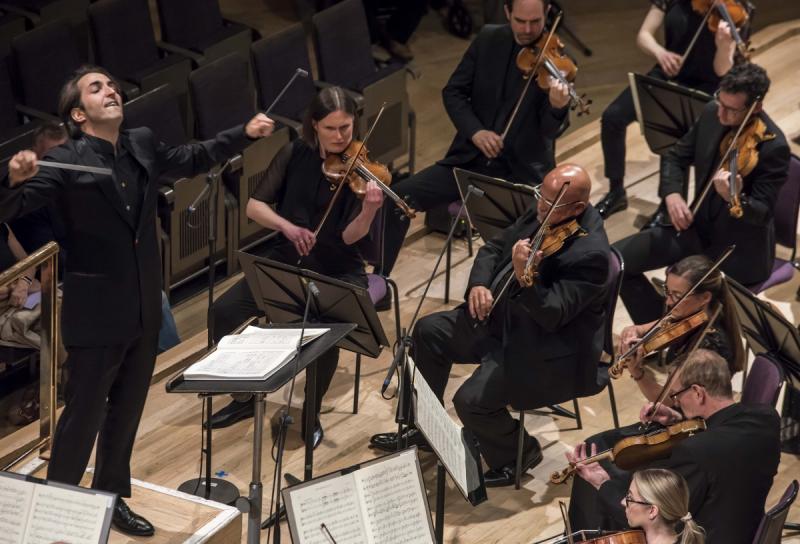Mahler's Ninth, BBC Philharmonic, Gamzou, Bridgewater Hall, Manchester review - vision and intensity | reviews, news & interviews
Mahler's Ninth, BBC Philharmonic, Gamzou, Bridgewater Hall, Manchester review - vision and intensity
Mahler's Ninth, BBC Philharmonic, Gamzou, Bridgewater Hall, Manchester review - vision and intensity
A composer-conductor interprets the last completed symphony in breathtaking style

There was a change of conductor from the one advertised for this BBC Philharmonic performance at the Bridgewater Hall – but the one who we heard from was an interpreter of extraordinary vision and intensity. Yoel Gamzou is also a composer in his own right, and a Mahler specialist, it would seem: he’s made his own completion of the Tenth Symphony, so he’s no doubt as aware of the language and creative imagination of that other composer-conductor as anyone.
Here it was the Ninth he brought to life, the only item on the programme in the event, as Britten’s Sinfonia da Requiem was simply dropped (there could have been interesting inter-work reflections between them, but that was not to be). At an hour and 35 minutes, in his reading, it was a concert in its own right, and you would be right to conclude that he does not rush it.
What he does do is to emphasise the expressionist and proto-modernist aspects of the writing, and to bring its emotional charge to the full in every aspect. If there’s one word that’s often been deployed to convey the essential quality of the symphony, it’s “valedictory” – but that applies most obviously to the first and last movements, which are (startlingly) both slow, often elegiac and long-drawn-out. Mahler himself would have said that the symphony should encompass a whole world in its discourse, and the other lands this experience visited were varied indeed.
The opening of the first movement – bare and seemingly almost atonal in its stark laying out of its fundamental motifs in the first bars – contrasted with a surge of feeling as the strings took up the tale, particularly in a palpable hesitation on the two up-beat staccato quavers when the first violins finally make their entry. This was to be flexible and passionate playing (Zoë Beyers leading), and though I wondered at first whether Gamzou’s extravagant gestures were going to hinder the orchestra’s reading of his exact beat, there were only occasional hints of any lack of unanimity.
The movement had drama in it, despite the measured pace of much of its progress, and when its acceleration came, the effect was all the more incisive. A sense of grotesquerie as the music reached the recall of its opening was becoming apparent, but gave way to its extended, nostalgic final pages with lovely solo playing from Beyers, Victoria Daniel (as principal flute), Javier Molina Parra (guest principal horn) … and Clifford Llantaff, making a welcome return to the ranks as guest principal harp.
Mahler asks for the playing in his second movement, which begins in his much-loved rustic waltz idiom of the Ländler, to be clumsy and rough. Well, it was never less than beautifully precise in the playing of the overlapping rhythmic figures involved, and Gamzou took its middle part at a good lick, before the introduction of what is really the whole work’s “motto” – the two-note sigh of a falling major second, which was touching, before an exciting finish to the reprised introduction. The third movement of the symphony was confident and achieved its purpose by more economic means as far as the conductor’s movements were concerned. Tempo changes were neat and smooth: the interruptions of the timpani to its more restful moments very pronounced (they’re certainly meant to stand out – maybe this time they did so a bit too obviously). Sub-principal viola Sarah Greene made her soulful presence felt in the solo viola’s melody, and the acceleration of the stretto and warp-speed concluding presto were thrilling.
 The last movement – “very slow and even holding back”, as Mahler marked it – was poised and heartfelt, the strings’ playing of the two main themes both focused and intense, and solo contributions from the wind as eloquent as before (and guest principal cello Karen Stephenson’s particularly memorable amid the delicacy of the full grouping). By the end it’s all about sustaining the sense of a calm so precious you hardly dare breathe – a tension unlike that of almost any other symphonic work – which Gamzou and the orchestra achieved amazingly. The sound of this pianissimo was tinier than any I’ve ever heard: you could have heard a pin drop, as they say, but no pin did, and it was a full 40 seconds after the last note died, when Gamzou finally closed the score, that the audience’s response erupted.
The last movement – “very slow and even holding back”, as Mahler marked it – was poised and heartfelt, the strings’ playing of the two main themes both focused and intense, and solo contributions from the wind as eloquent as before (and guest principal cello Karen Stephenson’s particularly memorable amid the delicacy of the full grouping). By the end it’s all about sustaining the sense of a calm so precious you hardly dare breathe – a tension unlike that of almost any other symphonic work – which Gamzou and the orchestra achieved amazingly. The sound of this pianissimo was tinier than any I’ve ever heard: you could have heard a pin drop, as they say, but no pin did, and it was a full 40 seconds after the last note died, when Gamzou finally closed the score, that the audience’s response erupted.
- To be broadcast on Radio 3 on 8th July
- More classical reviews on theartsdesk
rating
Explore topics
Share this article
Add comment
The future of Arts Journalism
You can stop theartsdesk.com closing!
We urgently need financing to survive. Our fundraising drive has thus far raised £49,000 but we need to reach £100,000 or we will be forced to close. Please contribute here: https://gofund.me/c3f6033d
And if you can forward this information to anyone who might assist, we’d be grateful.

Subscribe to theartsdesk.com
Thank you for continuing to read our work on theartsdesk.com. For unlimited access to every article in its entirety, including our archive of more than 15,000 pieces, we're asking for £5 per month or £40 per year. We feel it's a very good deal, and hope you do too.
To take a subscription now simply click here.
And if you're looking for that extra gift for a friend or family member, why not treat them to a theartsdesk.com gift subscription?
more Classical music
 Kilsby, Parkes, Sinfonia of London, Wilson, Barbican review - string things zing and sing in expert hands
British masterpieces for strings plus other-worldly tenor and horn - and a muscular rarity
Kilsby, Parkes, Sinfonia of London, Wilson, Barbican review - string things zing and sing in expert hands
British masterpieces for strings plus other-worldly tenor and horn - and a muscular rarity
 From Historical to Hip-Hop, Classically Black Music Festival, Kings Place review - a cluster of impressive stars for the future
From quasi-Mozartian elegance to the gritty humour of a kitchen inspection
From Historical to Hip-Hop, Classically Black Music Festival, Kings Place review - a cluster of impressive stars for the future
From quasi-Mozartian elegance to the gritty humour of a kitchen inspection
 Shibe, LSO, Adès, Barbican review - gaudy and glorious new music alongside serene Sibelius
Adès’s passion makes persuasive case for the music he loves, both new and old
Shibe, LSO, Adès, Barbican review - gaudy and glorious new music alongside serene Sibelius
Adès’s passion makes persuasive case for the music he loves, both new and old
 Anja Mittermüller, Richard Fu, Wigmore Hall review - a glorious hall debut
The Austrian mezzo shines - at the age of 22
Anja Mittermüller, Richard Fu, Wigmore Hall review - a glorious hall debut
The Austrian mezzo shines - at the age of 22
 First Person: clarinettist Oliver Pashley on the new horizons of The Hermes Experiment's latest album
Compositions by members of this unusual quartet feature for the first time
First Person: clarinettist Oliver Pashley on the new horizons of The Hermes Experiment's latest album
Compositions by members of this unusual quartet feature for the first time
 Gesualdo Passione, Les Arts Florissants, Amala Dior Company, Barbican review - inspired collaboration excavates the music's humanity
At times it was like watching an anarchic religious procession
Gesualdo Passione, Les Arts Florissants, Amala Dior Company, Barbican review - inspired collaboration excavates the music's humanity
At times it was like watching an anarchic religious procession
 Classical CDs: Camels, concrete and cabaret
An influential American composer's 90th birthday box, plus British piano concertos and a father-and-son duo
Classical CDs: Camels, concrete and cabaret
An influential American composer's 90th birthday box, plus British piano concertos and a father-and-son duo
 Cockerham, Manchester Camerata, Sheen, Martin Harris Centre, Manchester review - re-enacting the dawn of modernism
Two UK premieres added to three miniatures from a seminal event of January 1914
Cockerham, Manchester Camerata, Sheen, Martin Harris Centre, Manchester review - re-enacting the dawn of modernism
Two UK premieres added to three miniatures from a seminal event of January 1914
 Kempf, Brno Philharmonic, Davies, Bridgewater Hall, Manchester review - European tradition meets American jazz
Bouncing Czechs enjoy their Gershwin and Brubeck alongside Janáček and Dvořák
Kempf, Brno Philharmonic, Davies, Bridgewater Hall, Manchester review - European tradition meets American jazz
Bouncing Czechs enjoy their Gershwin and Brubeck alongside Janáček and Dvořák
 Solomon, OAE, Butt, QEH review - daft Biblical whitewashing with great choruses
Even a top soprano and mezzo can’t make this Handel paean wholly convincing
Solomon, OAE, Butt, QEH review - daft Biblical whitewashing with great choruses
Even a top soprano and mezzo can’t make this Handel paean wholly convincing
 Two-Piano Gala, Kings Place review - shining constellations
London Piano Festival curators and illustrious friends entertain and enlighten
Two-Piano Gala, Kings Place review - shining constellations
London Piano Festival curators and illustrious friends entertain and enlighten
 Echo Vocal Ensemble, Latto, Union Chapel review - eclectic choral programme garlanded with dance
Beautiful singing at the heart of an imaginative and stylistically varied concert
Echo Vocal Ensemble, Latto, Union Chapel review - eclectic choral programme garlanded with dance
Beautiful singing at the heart of an imaginative and stylistically varied concert

Comments
Hi Robert,If I may make a
Hi Robert,
If I may make a correction to your review, there was a last minute change in the Princical Viola and the player was actually Sub-Principal Violist, Sarah Greene playing the beautiful solos.
Thank you.
Corrected, with thanks.
Corrected, with thanks.